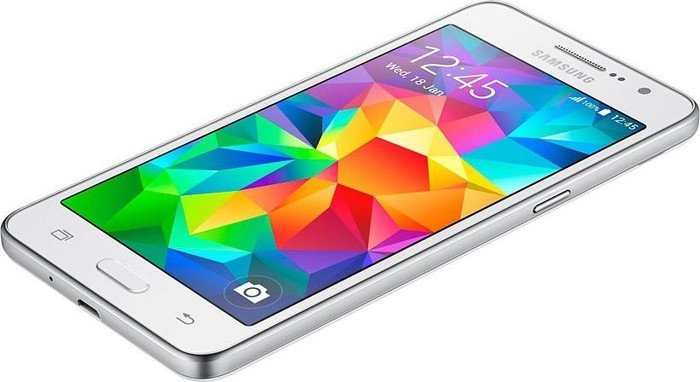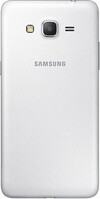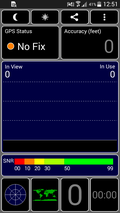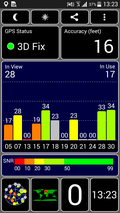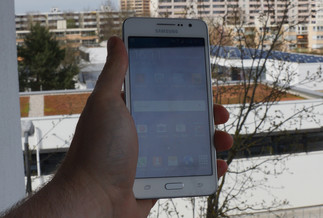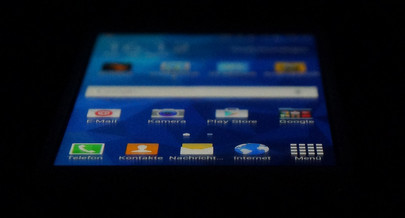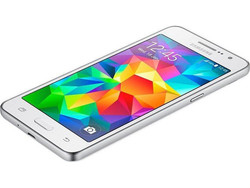Samsung Galaxy Grand Prime Smartphone Review
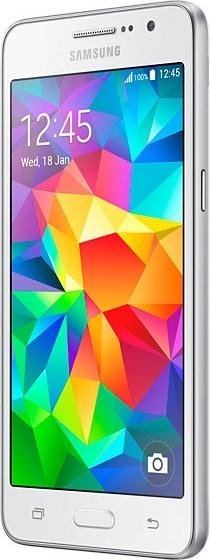
For the original German review, see here.
Samsung's Galaxy family is a bit confusing since you get Android smartphones for almost all target groups. The Galaxy Grand Prime is a new and pretty inexpensive smartphone that is designed for anybody who does not want to waive fast LTE but not pay more than 200 Euros (~$214) for a 5-inch smartphone.
In this price range and with LTE you mainly find devices from smaller manufacturers; we recently tested the Wiko Ridge 4G and the Xiaomi Redmi Note 4G. The prices of the Sony Xperia T3 or the Asus Zenfone 5 are lower by now, so they fit into this category as well.
Case
We cannot say that the Galaxy Grand Prime has an innovative design; it actually feels like a Galaxy S2 in the hand. This does, however, not mean that the Galaxy Grand Prime looks bad, but it does not appear as timeless or modern as the Galaxy A5, for example. You can still find typical Galaxy design elements like the home button as a stretched ellipse and the rounded corners.
The Galaxy Grand Prime is a pretty heavy device and we can measure 156 grams. There are much lighter smartphones in this price range like the Wiko Ridge 4G with 125 grams. The Grand Prime feels comfortable thanks to its rounded edges and the size is convenient as well.
One familiar Galaxy feature is the detachable back cover, which is available on the Grand Prime. The battery underneath can be removed and the slot for microSD and microSIM is combined.
The stability is basically okay, but the chassis can be twisted significantly and pressure on the display is also a problem for the smartphone.
Connectivity
All comparison devices have 8 GB internal storage, only the Wiko Ridge 4G has an advantage with 16 GB storage. Another nice feature is the NFC module, which is a small unique feature in this price range.
Software
Samsung's TouchWiz user interface on the Grand Prime is based on Android 4.4.4, and the manufacturer is still working on the version for Android 5. Samsung once again includes advertisement apps in the menu, but you can at least remove them pretty quickly. Otherwise, you just get the S Planner from the typical Galaxy software additions; the voice control S Voice or the news reader Flipboard are reserved for the more expensive devices.
Similar to other Galaxy devices you get used to the handling pretty quickly and the majority of functions work intuitively or are explained extensively on the display.
Communication & GPS
With four GSM, four UMTS and five LTE frequencies, the Galaxy Grand Prime covers more bands than the rivals that only support tri-band or even dual-band. You also get fast LTE with download speeds of up to 150 Mbps. The signal quality is average: We just had four out of five bars indoors, while higher-quality smartphones managed a full signal in the LTE network.
WLAN connections are possible via 802.11 a/b/g/n in 2.4 as well as 5 GHz networks. The signal quality is decent: With a distance of 10 meters from the router and through three walls, we still had 4/5 bars, but websites took a bit longer to open.
The GPS module is not able to locate our position in the building, but the situation is better outdoors, where the location is found pretty quick and accurate down to 6 meters.
Telephone & Voice Quality
We already know the Phone app from other Samsung devices and the handling is not complicated with its four tabs "Keyboard," "Protocols," "Favorites," and "Contacts." Video calls are directly integrated into the app as well.
The voice quality can convince us: The other person does sound slightly distorted at the maximum volume, but the sound is otherwise pretty balanced and the quality is very good when you consider the comparatively low price of our test device. The microphone records our voice clearly and we did not have problems with the hands-free feature, either.
Cameras & Multimedia
At the back of the Galaxy Grand Prime is an 8 MP camera with autofocus and LED flash. All in all it takes decent pictures: The colors are good and even larger colored areas appear uniform, but a closer look reveals some slightly pixelated edges. The sharpness clearly suffers in darker environments and the result is strong picture noise.
The front camera has a 5 MP sensor for decent selfies, but you will have to hold the smartphone very steady, otherwise the pictures will be blurred. You can quickly see individual pixels when you enlarge the pictures, but the camera is okay for occasional selfies and the use on the screen.
Input Devices & Handling
Samsung's virtual keyboard has pretty small keys at a first look, but the spacing is pretty big so you can still type reliably. The input options are limited compared to the bigger and more expensive Samsung smartphones: Only the voice input and swipe gestures are still available, but you will have to waive handwritten inputs. You have to get another keyboard from the store if you don't like Samsung's version since the manufacturer deactivated Google's standard keyboard.
The touchscreen is generally very reliable, but there is a small area at the bottom where it does not respond. This is probably to improve the separation between the screen and the software touch buttons.
Display
The Galaxy Grand Prime is not equipped with a high-quality AMOLED display that is used for many more expensive Galaxy models; it has a simpler LED screen. It is at least equipped with a TFT panel, which is not specified in detail, but the characteristics remind us of an IPS panel. The resolution is a bit meager with 960x540 pixels; all the rivals have at least 720p.
The brightness itself is actually okay, but almost all the competitors are even brighter. At least the brightness distribution of 90% is very good, so large colored areas appear uniform.
| |||||||||||||||||||||||||
Brightness Distribution: 90 %
Center on Battery: 426 cd/m²
Contrast: 513:1 (Black: 0.83 cd/m²)
ΔE ColorChecker Calman: 5.98 | ∀{0.5-29.43 Ø4.77}
ΔE Greyscale Calman: 6.03 | ∀{0.09-98 Ø5}
Gamma: 2.48
CCT: 7983 K
| Samsung Galaxy Grand Prime Adreno 306, 410 MSM8916, 8 GB eMMC Flash | Sony Xperia T3 Adreno 305, 400 MSM8928, 8 GB SSD | Wiko Ridge 4G Adreno 306, 410 MSM8916, 16 GB iNAND Flash | Xiaomi Redmi Note 4G Adreno 305, 400 MSM8928, 8 GB eMMC Flash | Asus Zenfone 5 Adreno 305, 400 MSM8926, 8 GB eMMC Flash | |
|---|---|---|---|---|---|
| Screen | 10% | 12% | 21% | 17% | |
| Brightness middle (cd/m²) | 426 | 521 22% | 459 8% | 446 5% | 389 -9% |
| Brightness (cd/m²) | 415 | 504 21% | 434 5% | 418 1% | 375 -10% |
| Brightness Distribution (%) | 90 | 89 -1% | 90 0% | 87 -3% | 88 -2% |
| Black Level * (cd/m²) | 0.83 | 0.77 7% | 0.35 58% | 0.47 43% | 0.58 30% |
| Contrast (:1) | 513 | 677 32% | 1311 156% | 949 85% | 671 31% |
| Colorchecker dE 2000 * | 5.98 | 5.73 4% | 9.69 -62% | 5.1 15% | 4.22 29% |
| Greyscale dE 2000 * | 6.03 | 6.83 -13% | 10.8 -79% | 5.93 2% | 3.08 49% |
| Gamma | 2.48 89% | 3.46 64% | 1.82 121% | 3.46 64% | 2.57 86% |
| CCT | 7983 81% | 8370 78% | 9063 72% | 7350 88% | 6840 95% |
* ... smaller is better
The contrast continues the pretty mediocre performance of the screen in the Galaxy Grand Prime: With 513:1, it is much lower compared to the rivals. This is a result of the lower brightness, but also the black value that is not really inspiring with 0.83 cd/m². This means black areas appear grayish and colors are pale instead of vivid.
Further tests with the spectrophotometer and the CalMAN software also show a blue cast, which is indicated by the increased color temperature of 7,983 Kelvin. The deviation of white is also very big compared to the ideal value of the reference color space sRGB. Blue is the only color that is somewhat accurate, red and orange colors in particular show high deviations.
Outdoors you will have to live with the very glossy display. The brightness would be sufficient, but the contrast is just not high enough to ensure a rich picture in bright environments, so you should use the Samsung Galaxy Grand Prime in the shade or inside, if possible.
Performance
Samsung equips the Galaxy Grand Prime with the Qualcomm Snapdragon 410 MSM8916, which was also the SoC of the Wiko Ridge 4G that is in our comparison as well. The other comparison devices are one generation behind with SoCs from the Snapdragon 400-series. This is noticeable in Geekbench, for example, which tests the processor. The Galaxy Grand Prime is clearly ahead of its rivals, and we could not notice any stutters in the menus or apps.
The GPU is called Adreno 306 and is also an evolution of the last generation Adreno 305, which is integrated into the majority of comparison devices. The differences are smaller and we can only see an advantage for the new chip in GFXBench.
Our web-browsing tests via WLAN show that the test device is similar to the rivals in all the benchmarks on average. We could not determine delays, either: The browsing performance was very fast as long as the signal quality was good.
The Wiko Ridge 4G is particularly good in respect of the read and write performances of the storage, but our Galaxy Grand Prime can keep up pretty well and is also faster than the other comparison devices.
| Geekbench 3 | |
| 32 Bit Single-Core Score (sort by value) | |
| Samsung Galaxy Grand Prime | |
| Sony Xperia T3 | |
| Wiko Ridge 4G | |
| Xiaomi Redmi Note 4G | |
| Asus Zenfone 5 | |
| 32 Bit Multi-Core Score (sort by value) | |
| Samsung Galaxy Grand Prime | |
| Sony Xperia T3 | |
| Wiko Ridge 4G | |
| Xiaomi Redmi Note 4G | |
| Asus Zenfone 5 | |
| GFXBench 3.0 | |
| on screen Manhattan Onscreen OGL (sort by value) | |
| Samsung Galaxy Grand Prime | |
| Sony Xperia T3 | |
| Wiko Ridge 4G | |
| Xiaomi Redmi Note 4G | |
| Asus Zenfone 5 | |
| 1920x1080 1080p Manhattan Offscreen (sort by value) | |
| Samsung Galaxy Grand Prime | |
| Sony Xperia T3 | |
| Wiko Ridge 4G | |
| Xiaomi Redmi Note 4G | |
| Asus Zenfone 5 | |
| Sunspider - 1.0 Total Score (sort by value) | |
| Samsung Galaxy Grand Prime | |
| Sony Xperia T3 | |
| Wiko Ridge 4G | |
| Xiaomi Redmi Note 4G | |
| Asus Zenfone 5 | |
| Octane V2 - Total Score (sort by value) | |
| Samsung Galaxy Grand Prime | |
| Sony Xperia T3 | |
| Wiko Ridge 4G | |
| Xiaomi Redmi Note 4G | |
| Asus Zenfone 5 | |
| Mozilla Kraken 1.1 - Total (sort by value) | |
| Samsung Galaxy Grand Prime | |
| Sony Xperia T3 | |
| Wiko Ridge 4G | |
| Xiaomi Redmi Note 4G | |
| Asus Zenfone 5 | |
* ... smaller is better
Games
Because of the comparatively low display resolution, the Adreno 306 is sufficient for smooth gameplay even with more complex titles like Asphalt 8. Simpler games like Angry Birds are no problem at all for the GPU. The controls via touchscreen and position sensor also worked very reliably in our tests.
Emissions
Temperature
We can measure a maximum temperature of 36.1 °C for the Galaxy Grand Prime. This is perceptible, but it is just a slight warming. The higher temperatures are also limited to the area around the camera, which is great when you use the smartphone in portrait mode, because the bottom, where you hold the smartphone, is the coolest part. The Grand Prime hardly gets warm while idling.
(+) The maximum temperature on the upper side is 36.1 °C / 97 F, compared to the average of 35.2 °C / 95 F, ranging from 21.9 to 247 °C for the class Smartphone.
(+) The bottom heats up to a maximum of 34.8 °C / 95 F, compared to the average of 34 °C / 93 F
(+) In idle usage, the average temperature for the upper side is 27.5 °C / 82 F, compared to the device average of 32.9 °C / 91 F.
Speakers
The sound is surprising because it is pretty rich for an inexpensive smartphone. Voices are very clear; bass is just indicated but at least available. The balance is not always perfect when you listen to complex music, but the maximum volume is sufficient in return. There are just slight distortions at the maximum volume.
Music enthusiasts will probably use headphones or external speakers. The provided headset actually does not sound bad, and the quality via 3.5 mm stereo jack is also pretty good with external speakers.
Energy Management
Power Consumption
The Samsung Galaxy Grand Prime is a pretty frugal device, which consumes at least 0.4 Watts while idling. Some rivals even need twice as much power in this scenario. The maximum idle value of 1.1 Watts is the lowest among the rivals. A maximum consumption of 3.5 Watts under load is a very good result as well.
| Off / Standby | |
| Idle | |
| Load |
|
Key:
min: | |
Battery Runtime
The battery capacity of the Samsung Galaxy Grand Prime is pretty big with 9.9 Wh. It is unfortunate that the smartphone cannot realize good runtimes, despite the good consumption values: It is roughly on par with the majority of rivals (our new WLAN test results in around 10% shorter runtimes compared to the old one), but it cannot really beat them. 8:32 hours wireless browsing is not a bad result, but the Xperia T3, for example, squeezes more runtime out of its slightly smaller battery, even when you consider the differences between the old and the new WLAN test.
| Samsung Galaxy Grand Prime Adreno 306, 410 MSM8916, 8 GB eMMC Flash | Sony Xperia T3 Adreno 305, 400 MSM8928, 8 GB SSD | Wiko Ridge 4G Adreno 306, 410 MSM8916, 16 GB iNAND Flash | Xiaomi Redmi Note 4G Adreno 305, 400 MSM8928, 8 GB eMMC Flash | Asus Zenfone 5 Adreno 305, 400 MSM8926, 8 GB eMMC Flash | |
|---|---|---|---|---|---|
| Battery runtime | 19% | -9% | 0% | 15% | |
| Reader / Idle (h) | 16.4 | 19.5 19% | 13.7 -16% | 16.4 0% | 18.9 15% |
| WiFi v1.3 (h) | 8.5 | 8.3 -2% | |||
| WiFi (h) | 10.6 | 11 | 9.1 |
Pros
Cons
Verdict
Samsung managed to get the smartphone crown in the high-end segment with its Galaxy S6, but the task is a bit more challenging for the Koreans in the mainstream sector, which is noticeable when you look at the Galaxy Grand Prime: There are just too many competitors with good devices nowadays.
Still, the Grand Prime is not a bad smartphone – quite the contrary: Some aspects are even really good. You get a lot of performance, the speaker is better than expected and the battery can be replaced. You also get LTE.
But you will have to live with some drawbacks in return: The chassis leaves a sophisticated impression, but does not win any design prizes, and it is also pretty heavy. The display cannot inspire us, either, because the colors are too pale. The battery runtimes are practical but could be better when you consider the pretty big battery.
The Samsung Galaxy Grand Prime is a solid smartphone in all sections, and the small drawbacks are more noticeable in comparison with the rivals than in practice. We are pretty sure many customers will be very happy with the inconspicuous device, but the very strong competitors might be worth a second look.
Samsung Galaxy Grand Prime
- 04/17/2015 v4 (old)
Florian Wimmer




